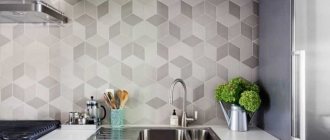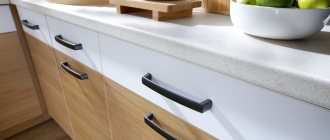Basic principles of ergonomics in the kitchen when planning
The term “ergonomics” itself came to us from the Greek language; literally translated, it consists of two derivatives “ergon” - work, and “nomos” - law. The term denotes a whole section of scientific research related to the study of the work of the human body and the relationship between labor productivity and energy expenditure.
Correct ergonomics in the kitchen is ensured through proper design and arrangement of furniture in such a way that the housewife spends a minimum of effort when working. Studies have shown that following the basic principles of ergonomics in the kitchen will save up to 30% of your time and make your work easier by 50%. Mainly due to compliance with the basic rule of the “working triangle” and compliance with the standards of kitchen furniture with proper placement of household appliances.
Neufert and ergonomics in the kitchen, the triangle rule
The term “work triangle”, familiar to many, was introduced by the German architect Neufert. He proposed optimizing movement between three main centers of activity: the sink, the refrigerator and the stove. Ideally, all three centers should be located at the vertices of an equilateral triangle, then the cost of moving the housewife will be minimal.
But in reality everything turned out to be somewhat more complicated. The layout of small kitchens and large ones, with a regular and elongated shape, may differ. However, the general principles of ergonomics in the kitchen remain the same in all cases:
- The sink is the main center of activity. According to research, the owner spends approximately 50% of all time near her. Therefore, its position, the location of adjacent modules with drawers and wall cabinets with drying should be as convenient as possible.
- The slab is the second most important center of activity. It is advisable to place it at a distance of 800-1200 mm from the sink, in large kitchens - up to 1800 mm. Optimally – as close to the dining area as possible.
- the refrigerator , freezer, and other modules used for storing food in the corner of the kitchen so as not to “tear” the work surfaces into non-functional areas. With proper ergonomics in the kitchen, the refrigerator should be no further than 1200mm from the stove and 1800mm from the sink. But with different kitchen layouts, this distance can either decrease or increase.
General ergonomics of the kitchen space depending on the layout of the unit
Comfort in the kitchen is ensured by many nuances. The less the housewife bends and squats to use the contents of the cabinets, or reaches to get something from the upper cabinets, the less she will get tired. Correct ergonomics in the kitchen also guarantees the absence of “dead” zones, when opening the door blocks the rest of the cabinets and drawers - this should not happen. Also, the level of the working surface should be at a level corresponding to the height.
Here are the TOP 5 useful tips on how to maintain proper ergonomics in the kitchen:
- When designing a kitchen set, consider your own physical parameters. So, the height of the working surface is determined by the arms bent at right angles at the elbows: there should be about 150mm between them and the working surface. And you will forget about back pain when cooking for a long time. Also, the maximum shelf level in wall cabinets should be at the distance of your outstretched arm minus 250mm.
- Make sure there is sufficient lighting on the work surface. Use spotlights for this above the main areas - sink, stove, food processing area. Also plan sockets for connecting household appliances; they should not “go” into the sink and stove areas, this is dangerous.
- Experience shows that the main injury and fire hazards arise near the stove. It should not be located in the aisle, near a pencil case, refrigerator or window with a curtain. The distance from the hob to the hood must be at least 700mm for an electric stove and 800mm for a gas stove.
- With proper ergonomics in the kitchen, the washing machine and dishwasher are located as close as possible to the sink and communications with drainage and water supply. Take care about the placement of sockets for them - they should not be located exactly behind the devices. In this case, in the event of a breakdown or emergency, you will have to pull them out first to turn them off, and this is not the best option.
- The quality of fittings, pull-out and lifting mechanisms is also important so that the ergonomics in the kitchen correspond to a high level of comfort. Doors should open without noise or creaking, just like roll-out and pull-out storage systems. The ease of operation and service life of kitchen furniture as a whole depends on this. If possible, install door closers on your kitchen cabinets; there are plenty of budget options.
Dimensions and distances in kitchen ergonomics
When organizing the kitchen space, it is important to correctly calculate the size of the furniture and the distance between different zones and objects. Some ergonomic rules are universal for any kitchen, and some vary depending on your height and the number of household members.
Optimal distances
To make cooking convenient, pay attention to the most important distances in the kitchen:
- From the car wash to other objects . Leave at least 45 cm of free space, because splashes are inevitable when washing vegetables and fruits or dishes.
- On both sides of the hob . Move 30-45 cm away from the stove and do not place anything in this place: it will constantly heat up and become dirty during cooking.
- From the countertop to the top row of cabinets . Install hanging modules at a height of 45 to 60 cm - the exact figure depends on your height.
Free opening
All kitchen cabinet doors should open easily and not collide with anything. To do this, it is important to leave enough free space in front of them.
Take a look at the diagram showing the minimum distances :
- at least 100 cm of free space in front of the module with the dishwasher
- In front of regular drawers, the headset is at least 90 cm ;
- Before washing - at least 100 cm ;
- In front of the oven - at least 110 cm .
In general, the optimal width of the space from the wall to the edge of the work area is about 170 cm .
Safety first
A gas or electric stove is a mandatory element of the work triangle, and at the same time it is the most “problematic” in terms of safety.
When organizing your kitchen space, it is very important to choose the right location for the hob:
- At least 45 cm from the window curtains so that the fabric does not touch the stove even in a gust of wind;
- Away from the entrance to the kitchen, so that there is no risk of accidentally touching hot dishes;
- At a distance of 35 cm or more from the refrigerator ;
- At a safe distance from the sink (minimum 50 cm).
The hob should not be close to a high cabinet or wall.
Comfort while cooking
If the height of the kitchen is not chosen correctly, your back will quickly get tired while working. Therefore, consider a convenient location for the tabletop - the standard height of 85 cm is not suitable for everyone. The working surface should be 10-15 cm below the waist line .
We advise you to choose the optimal height of the headset according to the following diagram:
- 75-80 cm – for height up to 150 cm;
- 85-90 cm – for height up to 174 cm;
- 95-100 cm – for height up to 186 cm;
- 105-110 cm – for height up to 210 cm.
Proper planning of ergonomics in the kitchen
With all the variety of planning solutions and design projects for the kitchen, all of them can be divided into several types depending on the configuration:
- Linear (straight) and double-row (parallel).
- Angular (L-shaped) and U-shaped.
- Island and circular.
In each layout option, you can follow the triangle rule - the basic principle of ergonomics in the kitchen to minimize the distances between the main centers. And also choose the best solution for placing all other kitchen modules, so that during the work process nothing impedes movement within the “triangle” or blocks the process.
Ergonomics of a linear straight kitchen
A kitchen set stretched out in one line is designed for elongated rooms. Correct ergonomics of a linear straight kitchen requires that the total length of the working surface is no more than 3.5 m. Otherwise the distance between centers will be too large.
If your kitchen is longer, include kitchen cabinets in the project for storing utensils and integrating household appliances.
It is best to place the refrigerator at one end of the kitchen, and move the sink to the center, between the stove and the refrigerator. True, this is not always possible; usually all communications for connecting the water supply and drainage are located in the corner of the kitchen. But there is an option to “move” the sink using a dishwasher or washing machine, which can be placed in the corner of the kitchen.
Ergonomics of a two-row parallel kitchen
A parallel layout in the kitchen is used in walk-through elongated rooms. As a rule, two key centers are located along one wall - a stove and a sink, and along the other - a dining area, a refrigerator and cabinets for storing food and kitchen utensils.
The ergonomics of a modern kitchen with a double-row arrangement of cabinets should take into account the possibility of free opening of all kitchen modules. For example, to open the oven or pull it out, the housewife needs a passage 1-1.2 m wide. And to open a narrow façade 300-400mm wide, you need less space. Design the opening of kitchen cabinets and cabinets so that the ergonomics of the kitchen space allows this to be done comfortably.
Ergonomics of a corner kitchen
A corner or L-shaped kitchen layout allows you to fully realize the requirements of Neufert's working triangle. The ergonomics of a small kitchen with a corner configuration will be most convenient, since the two key centers - the sink and the refrigerator, the refrigerator and the stove - will not be so far apart from each other.
In the case of a large, spacious kitchen, it is recommended to “move” the key centers to optimize the distance between them through additional pencil cases and other kitchen modules.
Ergonomics of a U-shaped kitchen
The U-shaped configuration of the kitchen set is an arrangement of kitchen modules along three walls of the room. It is possible to maintain correct ergonomics in a U-shaped kitchen if there is enough free space both for the housewife to move and for opening all cabinets and cabinets.
To do this, the minimum free space between two rows should be about 1200-1500mm. Otherwise, the kitchen will be cramped and uncomfortable.
Ergonomics of a kitchen with an island
Island compositions in the kitchen allow you to ergonomically space out work surfaces, making the kitchen more convenient and compact for movement between key centers. At the same time, the island can be effectively combined with straight, corner and U-shaped layouts - it all depends on the size of the kitchen and the personal wishes of the hostess.
The work surface of the island is most often used to place a stove or sink. True, it is quite difficult to arrange such a solution from the point of view of the possibility of supplying communications for connecting household appliances and a water supply system if it is planned to move a sink to the island. Therefore, the kitchen design project should be determined at the stage of rough renovation, with planning of sockets and water supply and drainage connections. The distance between the island and the bottom row of the kitchen should be sufficient for free movement and opening of all modules.
By the way, you can make a kitchen island with your own hands.
Rules for arranging furniture in the kitchen
What rules of kitchen ergonomics must be followed when arranging furniture:
- Leave plenty of space between any large furnishings (such as between a countertop and an island). With aisle widths of 110-120 cm, it will be convenient for two or three people to be in the kitchen.
- If there is a dining area in the kitchen, it should also be at least 1 meter from the worktop. Make sure that pulled out chairs do not block the passage. Ideally, the distance from the back of the chair to other kitchen furniture is at least 75 cm .
- If desired, the work surface can be made at different levels : for example, lower the stove a little, and, on the contrary, raise the sink 10-15 cm above the main countertop.
- The ergonomic arrangement of the kitchen in two rows or in the letter “P” suggests that between the parallel rows of cabinets there will be a free passage with a width of 120 cm .
Read on the topic: Choosing a straight sofa for the kitchen
Ergonomics of a small kitchen
To comply with the basic principles of ergonomics in a small kitchen, a corner configuration is most suitable. Depending on the size, it is often necessary to place all the key centers of the working triangle along one line. Since it is not advisable to move the stove to the edge of a small-sized kitchen in order to avoid traumatic situations.
With a competent approach to developing a design project, all large-sized household appliances can be placed in a small kitchen and at the same time provide the hostess with the most comfortable conditions. How? Check out the layout drawings for a small-sized kitchen - perhaps many points will become clearer to you.
Drawers
The general standards are discussed above, but now let’s pay attention to the height and quantity, because the convenience of being in the kitchen will depend on this. Again, manufacturers have several options.
The drawer has a minimum height of 170 mm. There are tall drawers in which it is convenient to store bulky dishes or kitchen appliances. There will be fewer of them, but at the same time they are taller - 360 mm.
Ergonomics of a combined kitchen with dining room and living room
A spacious kitchen often involves combining it with a living or dining area. Therefore, island kitchen configurations are more suitable for arrangement. The kitchen island seems to separate the kitchen space from the living space. At the same time, it often serves as a dining area - bar counters and dining tables are attached to it.
The U-shaped layout also lends itself well to the ergonomics of a large kitchen. In this case, one of the sides of the U-shaped configuration is not located along the wall, but separates the kitchen space in the form of a kind of bar counter.
If the room allows, you can use a circular kitchen layout - giving a rounded, streamlined shape to an island or U-shaped configuration. Such design solutions look especially impressive in modern interior solutions.
Kitchen set layouts
Kitchen units should be selected depending on the layout of the kitchen (standard or non-standard). A square or rectangular room does not cause any particular problems and allows you to purchase almost any set. With a non-standard layout with beveled corners and niches for communications, preference should be given to making a custom-made headset. Manufacturing companies provide their services for the design and preparation of a kitchen design project, taking into account individual dimensions. The diagram is created by an experienced specialist, who usually visits your home to measure and calculate the future kitchen unit. The dimensions are determined depending on the location of communications and the dimensions of the room in order to make the most efficient use of every centimeter of free space. Next, the project is submitted to the customer for approval, and after that the company proceeds directly to the manufacture of furniture.
The “ideal” size of a kitchen door is 720x450 mm, this is the size that is perceived by most people as the most aesthetically pleasing
There are the following types of headset layouts.
- A direct kitchen is the most budget-friendly and versatile option. For a standard layout, this arrangement allows you to equip a comfortable and compact workplace. The kitchen set is located in one row against a long wall, without corners or turns. If its length exceeds 3.7 m, you should consider moving the refrigerator opposite or to the side to comply with the triangle principle. Otherwise, the housewife will have to constantly move along the entire kitchen, which is not conducive to efficient work. The advantages include the relatively low price of furniture, since individual production is inappropriate here. To purchase a headset, it is enough to know the height and length of the wall. In order to ergonomically use the space, it is advisable to choose a high set of 3 tiers from floor to ceiling. This will visually increase the size of the kitchen, and the mezzanine will provide additional storage space for kitchen utensils.
- The corner kitchen is in greatest demand because it is suitable for rooms of any size: from a small Khrushchev apartment to a studio apartment in a new building. A standard set in the shape of the letter L or L creates the most comfortable conditions for the housewife in the process of cooking, visually combining the stove, sink and refrigerator. It is important that the distance between them does not exceed 1.5 m, otherwise you will have to make unnecessary maneuvers, moving from one object to another. When developing a project, you should pay attention to the configuration and depth of the corner. The beveled corner looks unusual and original, but it will be difficult for overweight people to reach the corner sink and the upper shelves. There may also be problems when cleaning the wall. A right angle is the best option, but its depth should not be too large.
- G-shaped kitchen is suitable for square spaces. The set is located along three walls, and one of the sidewalls is adjacent to a perpendicularly located tabletop, which can serve as both a work surface and a bar counter for a quick snack. This arrangement is common in kitchens combined with a dining room or living room, because the counter additionally performs the function of zoning the space.
- The island layout involves a free-standing module in the center of the room with a built-in sink and hob. Its distance from the floor should be equal to the height of the main set (85–90 cm), however, the standards can be changed at the request of the customer or due to certain technical nuances. For example, when moving a sink, it is necessary to ensure a certain slope of the pipes so that blockages do not occur. To do this, the island is raised from the floor by 10–20 cm.
Basic types of kitchen layouts
Corner L-shaped layout is the most common, and in a small kitchen it is simply irreplaceable
The work triangle and kitchen standards: rules for ideal placement
The so-called working triangle rule plays a special role in creating the correct layout in the kitchen. Compliance with this aspect of ergonomics allows you to rationally distribute space and make work in the kitchen as easy as possible. The range of this zone includes three places:
The work triangle plays an important role in creating a comfortable layout
- work surface of the countertop and stove;
- area where the refrigerator and food cabinets are located;
- location of the sink.
Thus, the triangle area includes such important functional appliances as the refrigerator, stove and sink. At the same time, their location next door is absolutely undesirable. Ideally, each of the components should be located in one of the corners of the imaginary triangle.
There are many options for furniture placement taking into account the work triangle. This useful functionality provides free access to the listed items and safety of their use. Thus, without particularly changing the position of the body, a person can easily reach each of the zones. Simply put, everything you need is at hand during the cooking process.
The ideal layout in the kitchen is when a person does not make unnecessary movements, since everything is at hand
Helpful advice! The width of cabinet door leaves should range from 30-45 cm. Wider doors will not be very convenient to open.
An important point in creating a drawing of a kitchen set with dimensions is the correct arrangement of items related to large household appliances. The dimensions of a built-in washing machine or dishwasher must be taken into account when developing a sketch of the lower tier. The width of the refrigerator should allow for a certain margin, since this unit vibrates during operation and should not fit closely to the wall and cabinet walls.
Where should the sink be?
And then it is necessary to calculate the parameters for the other vertices of the triangle, because the countertop is not only a table for preparing food, but also a sink and a hob. Let's start with the sink. Since every centimeter is important to us, we again take on the calculations.
To calculate the optimal sink height, you need to:
- Bend your arm at the elbow and measure the distance from the concave arm to the floor.
- Bend your palm into a fist and measure its height. Fist height is the distance from the thumb to the little finger.
- Subtract the second from the first value. The resulting difference is the optimal sink height.
If you often wash dishes, you have to bend down, it is more convenient to make the sink slightly higher than the main work surface, at a distance of about 10 cm from the elbow. However, in practice, the opposite often happens: the sink is located lower - this makes it more convenient to put dirty dishes in it. How to position the sink - be guided by your feelings. Ergonomics only gives recommendations, but does not dictate anything. In addition to height, the sink has other dimensions, and they should suit your needs. Everywhere you need an individual approach.
What does ergonomics dictate?
The main work surface in the kitchen is the countertop. Vegetables are chopped on it, meat is beaten, and dough is kneaded. To make all these operations convenient and not tiring, it must be correctly located. Ergonomics dictates in the kitchen compliance with the rule of the “golden triangle”, the vertices of which are the stove, sink, and work area. The distance between them should be as convenient as possible so that the housewife does not have to wind up extra meters when moving from one zone to another. Any unnecessary movements in the kitchen are a source of fatigue and discomfort.
On the other hand, the stove should not be placed next to the sink to prevent splashes from flying onto the hob. A work area should be located next to the sink - this makes it more convenient to wash food before cooking. Follow these rules whenever possible. We've sorted out the horizontal placement a bit, but what about the vertical one? In other words, at what level from the floor should the tabletop be located to achieve maximum comfort?











